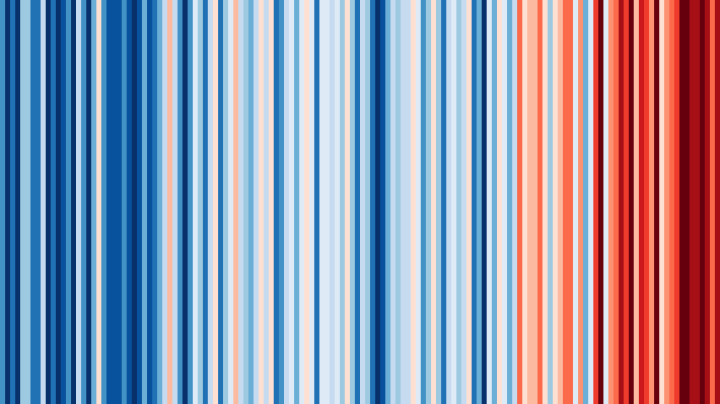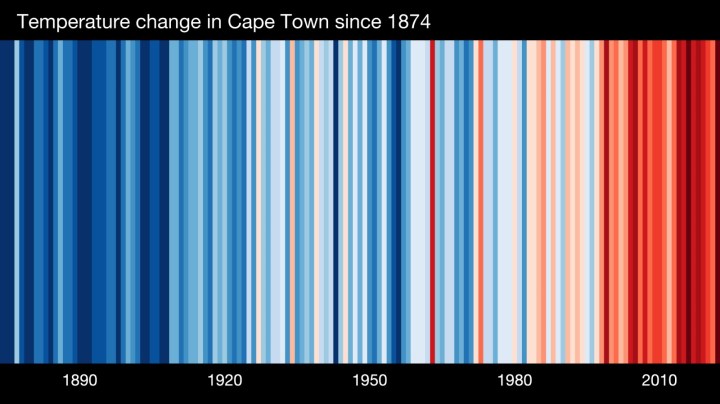SPONSORED CONTENT
Climate change stripes cast a dire shadow on the world

If A PICTURE tells a thousand words then a graphic designed by Professor Ed Hawkins five years ago, tells an entire story. And, let me let you into a little secret right now; this story doesn’t end well.
The graphic is a panel of stripes; four colours running from top to bottom; from dark blue, through to white, orange and ultimately dark red. Each one is a year. When the stripe is blue, that was a good year, from a global warming perspective. When it’s red, well you know what rhymes with that.
It need not be like that. There is so much we can do and indeed so much that we can do. In the 1980s, the great challenge was the hole in the ozone layer that threatened to burn us all to a crisp by 2050. Today that is no longer a concern. We won the war by working together.
We can rewrite the end of the story that is climate change too, but to do so we have to work together. The importance of Hawkins’ climate stripes infographic, with its ability to let viewers zoom right into their own cities and countries to see what is happening there, is that it provides a rallying point. A stark, recognisable clarity.
As Noah Yuval Harari points out, humanity needs stories to make sense of its world, to discover the purpose to be able to coalesce and work together for the greater good. This graphic is the starting point to our story. When you drill down to look at the story for a particular region, it becomes very clear that the African edition is not ending well. It hasn’t been for years now.
It is one of the great – and bitterest – ironies that Africa supplied the mineral and the human resources to effectively power the industrialisation of the northern hemisphere, in particular Europe and the USA but has to shoulder the brunt of its consequences.
Extreme weather events, directly caused by climate change, are increasing in scope, scale and regularity. Africa gets hit worse than other regions. Droughts follow floods, famine and disease follow both. The net result is an exponential increase in insecurity; political, economic and social as groups contest one another, no longer for mineral resources but rather for basic resources such as drinkable water, shelter and food.
Where there are none available, the exodus begins anew; entire communities fleeing to neighbouring countries – and to Europe and the US – where they are seen as much as a biblical curse as the locusts that presaged the very first Exodus. That is just one aspect of the catastrophe bearing down upon us, the others are as ominous; the extinction of more and more entire species and the pollution of the very air we breathe.
All of this we know, and yet we ignore it, because we are biologically constructed to react to imminent direct threats but not to those which are abstract, which is why Hawkins’ infographic is so powerful. This is no abstract concept but a devastating picture drawn from scientific fact. The redder stripes there are; the more damage is being done. Without our action, one day the red will be replaced by black because the planet will be dead.

Developed through the research done by Prof Ed Hawkins, of University of Reading
This is an easy concept to grasp. As Hawkins intended, it transcends language, culture, class, creed and background. No matter where you live, climate change affects you and everyone else on every corner of the earth. This is why the University of Reading’s #ShowYourStripes campaign is so vital: Every year on the summer solstice in northern hemisphere, the university #ShowYourStripes to get people talking about climate change and, more than talk, start a movement to get their own governments to change.
There is much we can do here in Africa – and especially in my adopted home country, South Africa. We need to have more than just a conversation about a just transition away from a carbon intensive electricity grid, we need a timeline of action. We need a plan to deal with all the other problems we face, because the only guarantee we have is the certainty that the ravages of climate change will make the inequalities that exist an even greater faultline for upheaval and conflict.
If South Africa was to overlay its own underlying social and economic crises as a country on top of the existing graphic tracking climate change, our picture and our story would have far more red on it than any normal society could safely sustain.
Time has run out for complacency. We have to act. Let’s show our stripes not just in solidarity with the world, but as a rallying cry for all of us who deeply care about this country, this continent and the world we hope to leave to our children and their children to do something practical about it. And we can’t hesitate because we think we won’t win or it’s too late. Like army ants that form a bridge of their bodies to cross water, we need to push the boundaries back so those who follow us can win.
In 2010, when we hosted the soccer world cup, we said, Ke Nako, it’s time for Africa to change the world’s perceptions about us. In 2023, we say again, Ke Nako, but this time, it’s time to save the world because if we don’t Africa will suffer first.
We can stop climate change and we can also reduce inequality in all its various guises. We will do this by building prosperous societies, creating sustainable jobs, providing shelter and services for all, laying the foundation stones for peace and stability from the Cape to Cairo – and every point in between. DM/OBP
Author: Professor Jon Foster-Pedley , Dean and Director of Henley Business School Africa, a constituent part of the University of Reading in the UK.
- If you would like to take part in this year’s #ShowYourStripes campaign, you can go to www.showyourstripes.info to download the graphic, as well as to find out how climate change is affecting your country or even the city you live in. You can take part in the day by using the hashtag #ShowYourStripes to post your own contribution and see how the campaign is playing out in different parts of the world.

















 Become an Insider
Become an Insider